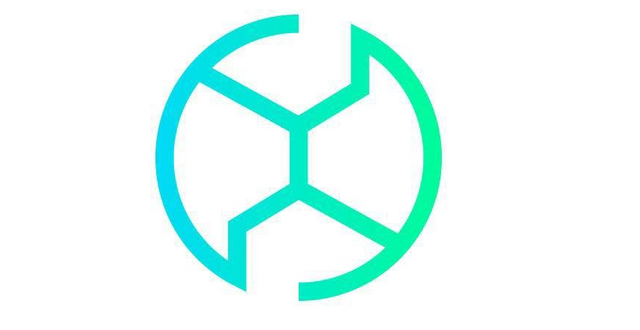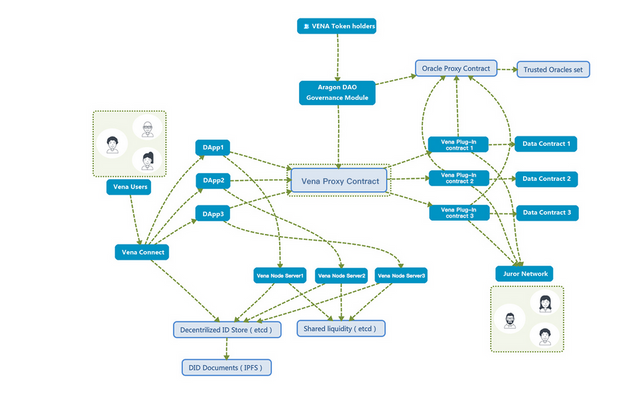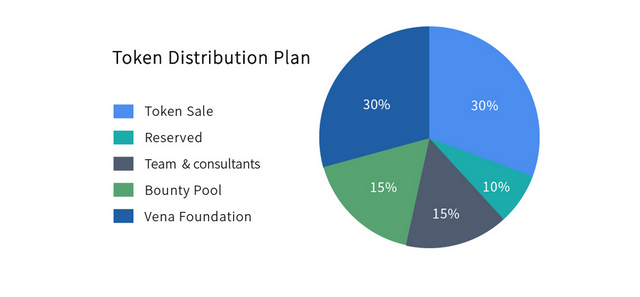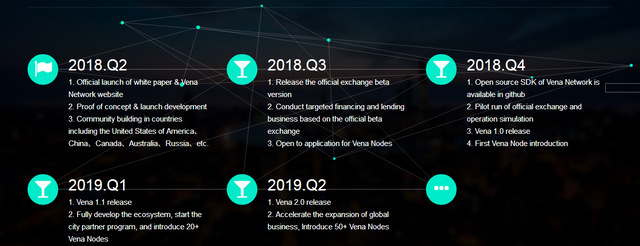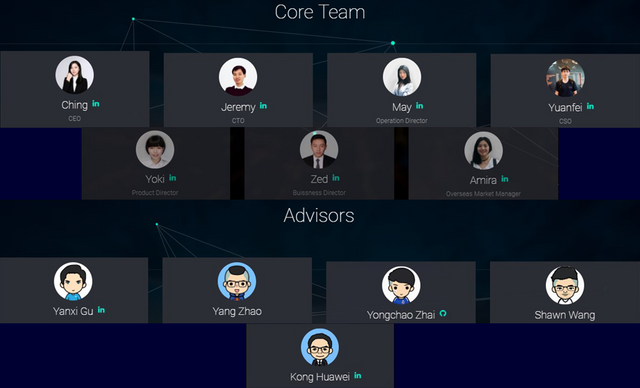Vena Network— An Open protocol for tokenized Asset financing and Exchange
The digital economy is growing rapidly. In 2012, the Boston Consulting Group estimated that the potential volume of digital economy in G20 countries reached 4.2 trillion US dollars. In addition, another evaluation, based on the joint study made by the Department of Economics of Oxford University and Accenture in 2015, pointed out that the digital economy will contributed 1360 billion US dollars to the global gross domestic product by 2020. As the demands for online payment grows with the rapid development of digital economy, cryptocurrency is becoming an increasingly popular payment solution which can meet the demands of digital economy.
Blockchain represents the network of value transmission constructed by a series of characteristics such as decentralization, immutability, trustlessness, etc. The P2P reliable trust can be established in the network with blockchain technology so that the value transmission process shall break away from the dependency on intermediary agent for realizing the functions between information disclosure and privacy protection, and between codetermination and individual interest protection. Such mechanism shall promote the efficiency of value interaction and decrease the transaction cost.
Today, there are thousands of cryptocurrencies throughout the world, and everyone can hold them safely. However, in many regions in the world, the transaction between cryptocurrency and fiat currency is still difficult, and the cost is very high, which hinders the popularization of cryptocurrencies and distorts the transaction price. At present, the transactions between cryptocurrency and fiat currency are mainly conducted through centralized OTC trading platform. Most countries haven’t established the legislation of cryptocurrency, which means that such platform can be run without any license and regulation. Therefore, users on such platform always have to bear the risk in both fund safety and privacy disclosure; meanwhile, the trading platform may manipulate the transaction price to earn excess profits.
In the centralized cryptocurrency exchange, such as Poloniex, Bitfinex etc., USDT is used as the digital substitute of USD for transaction. However, as a centralized digital currency to anchor US dollars issued by Tether, there have been a number of severe problems existing in USDT, including:
- Tether may goes bankrupt.
- The bank which Tether opens its accounts may goes bankrupt.
- The bank may freezes Tether’s funds.
- Tether may excessively issues USDT.
- High service charges, slow settlement, and difficult to withdraw funds.
- The security problem that the accounts in Tether was stolen once happened.
Obviously, the demands for the digital substitutes of fiat currency such as USDT will decrease significantly if the users are able to safely and conveniently conduct transactions between cryptocurrency and fiat currency.
Another obvious problem in the field of cryptocurrency is that there is no decentralized service to enable the cryptocurrency holders to safely borrow fiat currency by pledging cryptocurrency, but it has become a noteworthy demand, especially for the users who hold a large amount of cryptocurrency, and believe that the cryptocurrency price will rise. Meanwhile, global investors of fiat currency are also looking for a low-risk and high-yield investment channel, and the collateral loan market has been in their good graces. The centralized collateral loan service providers always earn excessive profits via their monopolistic advantage; what’s more, they would also be more easily affected by factors such as market price fluctuation, poor operation and management, inner corruption, regulating policy change etc. In addition, the users’ concern about privacy disclosure risk is also another reason why they transfer to the decentralized service.
Taking a view at ICO (initial coin offering), under the ERC20 token standard, the Ethereum blockchain has constructed a diversified cryptocurrency secondary market ecosystem in a license-free and interoperable manner. The high liquidity of cryptocurrency in the secondary market has attracted an influx of innumerable investors and helped trigger the ICO frenzy, which actually improves the status quo of traditional equity financing. However, debt financing has similar pain points as traditional equity financing. Debt financing in public offering or private placement, like the implementation of equity financing, is customized and inefficient, which means that the debt market is still non-transparent and proprietary. Before I proceed lets take a look at the video below to have an insight on what am going to discuss
VENA NETWORK
This platform is an open protocol for tokenized asset financing and exchange through creating a protocol that introduces generic smart contracts for the purpose of making a vast array of secure and trustless financial deals.
AIM
To create a decentralized digital asset financing and exchange network through Vena Protocol. The Vena Protocol is divided into two layers:
Basic protocol layer:- This deals mainly with registration, configuration, routing, and management of upper layer financial businesses.
The asset protocol layer:- This is based on assets, completes user-defined financial businesses through the implementation of the terms contract interfaces.
ADVANTAGES OF VENA
Offline Transaction
Centralized OTC Exchange
Centralized Collateral Loan Institutions
Credit Loan
Debt Financing
CHARACTERISTICS OF VENA NETWORK
Construct the distributed commercial network by using tokenized economic model
Users shall get decentralized identity authentication to conduct credit and fiat currency related transactions
Well-defined protocol design. The basic protocol layer is highly abstracted to improve the degree of freedom for secondary development, bringing more ecological roles with more innovation scenarios; the asset protocol layer endogenously supports standard contract library including debt contracts (debt issuance, credit, collateral loan) and trading contracts, which acts as a business forerunner to build an asset financing and exchange ecosystem.
Achieve closed-loop circulation of digital assets from asset issuance to the secondary market trading, and can directly complete spot transactions, right of pledge transfer, and the circulation of collaterals (only supporting Stable Coins) within the Vena Ecosystem.
Support NFT (non-fungible token) standard and achieve value-added collateral loan for portfolio through self-defined terms contract
The third party implementing template contract library in asset protocol layer will retain the copyright, thereby establishing a template contract transaction and service market, and the author may charge the user for the service fee.
Different roles in protocol ecosystem will receive compensation, for example, appraiser can use its own data model to provide users with quality credit evaluation services and gain profit.
Support ETH, ERC20, BTC, EOS, and BCH, and more cryptocurrencies in the future
Support the transaction between cryptocurrency and fiat currency and the collateral loan
Solve the risk that the counterparty viciously withdraws from the transaction by smart contract with time lock (Timelock Contract)
Only support the irreversible fiat currency transfer so as to minimize the risk of refund (see https://en.bitcoin.it/wiki/Payment_methods)
Distributed jury network works as main protection mechanism for fiat-to-cryptocurrency exchange.
Restrain the transaction amount (50ETH) in transactions involving fiat currency to lower the overall risk exposure
All transaction details are held in smart contract and signed by both trading parties, which can be used as evidence when there is a dispute.
Regularly call the price predictor oracle contract through clocks of differenct chains ( such as ethereum-alarm-clock), and obtain the real-time price of token from the trusted-oracles-set
Solve the risk of collateral price falling through compulsory liquidation mechanism
Solve the risk that the collateral price quickly falls below the debt amount (no time for compulsory liquidation) through additional protocol token issuing mechanism
Implement the decentralized governance with Aragon software
Safely construct and manage smart contracts with Zeppelin_OS
Issue source code with open source permit (AGPL)
BUSINESS MODEL OF VENA NETWORK
Vena Network is an open source project to fill up the gap of cryptocurrency ecosystem rather than a company. Vena Foundation is a non-profit organization established by Vena team in Singapore. The purpose of establishing Vena Foundation is to guarantee the sustainability of Vena project, the effectiveness of decentralized governance, the safety and transparency of fund raising, and the development and business innovation of assisting start-up enterprises based on Vena Protocol.
To promote the healthy development of Vena Network, a comprehensive incentive mechanism has been established by Vena Foundation, mainly including:
The Vena node acting as an Appraiser or Relayer should be reviewed and approved and pledge a certain amount of VENA Tokens to the Vena Foundation as a deposit, and the node can make a profit by charging fees.
The juror node should be reviewed and approved and pledge a certain number of VENA Tokens to the Vena Foundation as a deposit. At the end of each arbitration, jurors which gave reasonable ruling would receive token rewards, and jurors which gave unreasonable ruling would suffer token losses (see 5.2.3 for details).
Users are given a 50% discount when using VENA Tokens to pay fees.
Users can get a higher collateral rate and a lower liquidation line when they use VENA Tokens as collateral.
When making across-chain trading, the relay node cross-synchronize block head data will receive a reward of VENA Token. The miners making smart contract computing verification that are elected to "quadrant layer" will receive Vena Tokens as rewards.
VENA Token holders can participate in the governance of the Vena Protocol and vote on the proposal of protocol improvement proposed by the protocol developers.
THE ECOSYSTEM
TOKEN DISTRIBUTION
ROADMAP
MEET THE TEAM BEHIND THIS PROJECT
C.E.O: Ching Zhu. An excellent performing honours student from UESTC and is also the founder of chainboard technology.
C.T.O: Jeremy Lan. A blockchain engineer, co-founder and CTO of hardrole.
Operation director: May Du. A richly experienced entrepreneur, who hold a post graduate degree of finance from Nanyang technological university, China.
C.S.O: Yuanfei Zhu. A top student recommended for admission to Shanghai jioa Tong University as a top student, majoring in computer sciences. He later went on to found moregg during his suspension of school.
Business director: Zed Zhao. A graduate of UESTC, a former project manager at UETC, saw to the creation of encrypted platform and cyber security system for armed police.
Product director: Zoki wang. A graduate of UESTC, who is very rich in knowledge about the internet industry, having previously worked for reputable internet companies.
Overseas market manager: Amira Zhou. A practitioner with years of experience in business negotiation and project management.
For more information, please visit:
Website: https://www.vena.network/en.html
Whitepaper: http://whitepaper-en.vena.network/#51-the-overall-architecture-of-vena-network
Telegram: https://t.me/vena_network
Twitter: https://twitter.com/VenaProtocol
Facebook: https://www.facebook.com/Vena-Network-207271413455484/
Medium: https://medium.com/@457597870
Github : https://github.com/venanetwork
Author: Seunola
MyBitcoinTalk profile: https://bitcointalk.org/index.php?action=profile;u=1925064
ETH Address: 0x3eb48CF7E0A5570540641DD8263cA40e307562e9
